
What price Broughaminess? How about three grand, give or take.
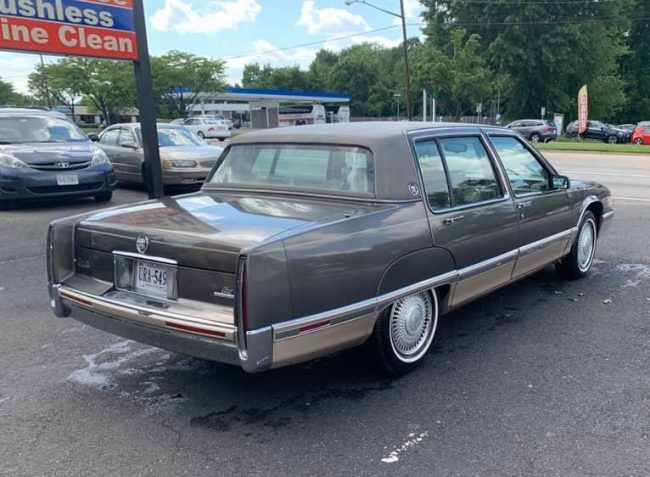
That’s the ask for this rather nice example of the 1989-1993 Cadillac Fleetwood/Sixty Special. Originally deemed Fleetwood, with a “Sixty Special” option that added excellent, 22-way power seats designed by none other than Giorgetto Giugiaro.
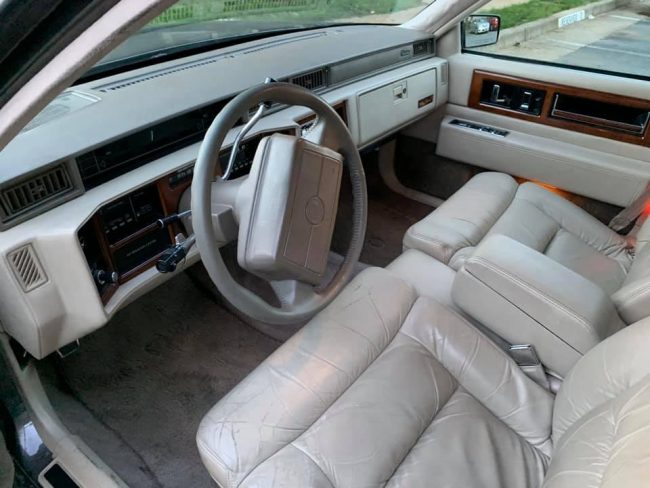
And so the model names remained until 1993, when the 1977-style RWD Brougham (though it had new sheetmetal in ’80 and a facelift in ’90, it was still a very ’70s land yacht visually) was finally redesigned and renamed Fleetwood (with a “Brougham” option of course). So for one year only, the FWD ex-Fleetwood became the Sixty Special.
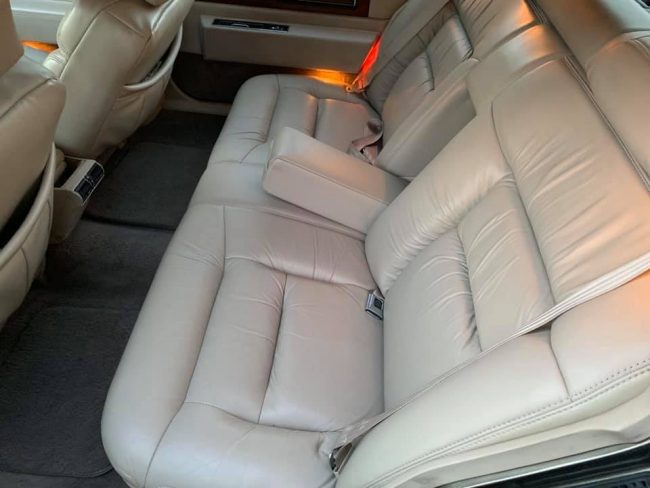
And this is what we have here. These cars are mocked by the usual suspects online, but I always liked them. Our neighbors traded in their 1987-88 Ninety-Eight Regency Brougham for an Academy Gray ’91 Sedan de Ville with dove gray leather, and I always liked that car.
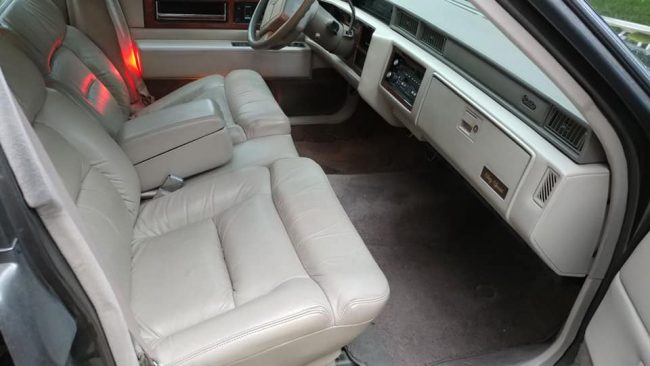
According to my Cadillac compadre Jayson Coombes, the color is Slate Bronze, a ’93-only color. Anyway, if one is so inclined, it’s currently on FB Marketplace here. I drove many of these over the years, and always enjoyed them. Good power from the 4.9 V8, amazing glass area, and impressive room inside. If I had the space, I’d be very interested.
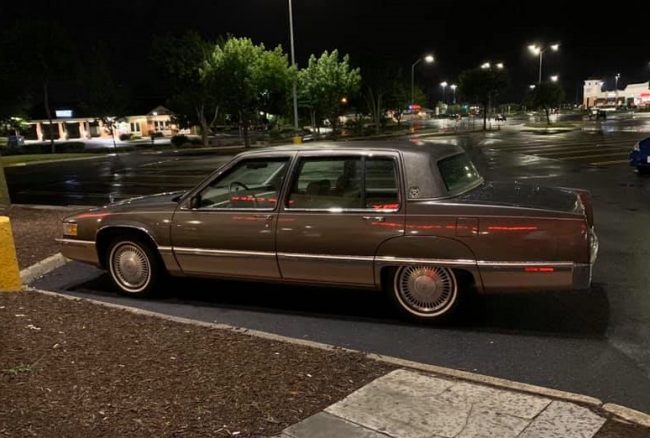







21 Comments
I like the last photo……at the Twin Pines Mall, waiting for the Libyans….
I always liked these, the 1989 re-style got rid of the “underweight” look that the 1985-1988 cars had . I always thought it was cool how Cadillac was able to use the same rear quarter on the fender skirt Fleetwood and the open wheel deVille cars by using a removable wheel lip molding. Fender skirt Fleetwood for me please. min
These were also the last Cadillacs with a factory opera lamp, on the vinyl top cars the Cadillac crest would light up. That leather looks so soft you just want to dive into the seats.
Did C/D or R/T or MT even bother to road test one of these with the 200 hp 4.9 transverse V8. You would have thought they would have if only to sneer at torque steer. They probably thought the test of the 85 with 130 hp was good enough. A million extra horsepower wouldn’t have helped that one in their tunnel vision eyes and of course they had no respect for any engineering effort with the aim of retaining a traditional Cadillac experience through a challenging tech update. One so challenging that Lincoln and Imperial were satisfied with stretched midsizes and poor mannered 90 degree V6s. It is amazing the arrogance and small mindedness tolerated among the auto press of the period.
Stop living in the past, what the magazines did 30 years ago doesn’t matter anymore. Stop chasing the bogeyman.
What would be the point of talking about a car from 1993 if you didn’t want to live in the past for a moment.
Why cause yourself stress? Look at the positive, those magazines are now struggling from a loss of GM’s ad spend.
Surely their year after year investment in Honda and BMW and now Hyundai have left them sitting pretty. To not believe that might imply they placed their bets on the wrong horse and the destruction they wrought was all in vain.
There was a C&D road test of a red on red Sedan deVille, it wasn’t a full test but a short take, from what I recall they were pretty complementary for Accord and 3 Series monthly…….
So you remember who wrote it? I would be curious as someone would have had to fight hard to go against the editorial staff’s conventional wisdom.
Also do you remember what number they got on 70mph cruising. My memory is even pathetic short takes had full instrument testing so to be included in the road test summary. The best number I remember from that period was 63db for an 86 Toronado. They had a tendency to test the Eagle GT touring suspension version, but I bet a better number could be had from the standard Michelins. It would be interesting to measure the advantage or disadvantage over the more expensive early LS400. That was the car that import humpers thought went as far as could be gone on quietness with cost no object. I am confident the FWDs beat the RWDs period GM due to the more modern window sealing.
The problem for Cadillac at this time was this would have been a nice Buick, but having such an old-fashioned car in the Cadillac lineup turned off young professionals to even considering a Cadillac as they drove by on their way to the Acura, Lexus, BMW, Volvo, or Mercedes dealers. Very few 40 year olds with enough money to buy a luxury car want the same style or brand that their grandparents drive. It also didn’t help that they spent most of the 1980s making cheap, slow, unreliable junk – i.e. unreliable V-8/6/4, tarted up Chevy Cimarron, self-destructing Olds diesels, lethargic Buick V-6s, self-destructing/slow 4.5 V-8s, forest loads of unconvincing plastic wood and fake chrome, etc. all helped destroy the Cadillac brand in the minds of most anyone under 60 years old who didn’t have strong memories of the great Caddies of the 30s to the mid 60s. Whoever bought this one in 1993 sure took good car of it, and it looks like a lot of car for the just over $3K.
I know you perceive that as a trouble and remember Cadillac offered a Seville STS more directed at their import or bust sensibilities. But which of the models you tick off above sold in the six figures annually like the Deville/ 60 Special did. None of them.
The attitude that the Deville was an embarrassment was very damaging to it in the next generations. The drive by sneering of the press combined with a management shift at GM that saw Jordan replace Ribicki upon his retirement. Jordan had spent much time at Opel and had gone native as sometimes happens with colonial governors. Suddenly it was okay for the next Deville to be just an austere trim group on a Seville with little thought given to the fact that the two cars were for people of different sensibilities and therefore should ride and handle differently. You also had the NorthStar V8 that mimicked the power delivery of foreign V8s replace the 4.9. Imagine the unique advantage of the V8 in a front drive being squandered on me too power delivery. How sad.
The problem with GM is they didn’t know how to utilize their division structure to compete in different segments. Olds could have used the Aurora as a FWD premium platform to compete with Acura (and Saab), but they would need to get rid of the 88s, Aleras, Silhouettes, and everything else that was not near-luxury premium/sporty. Buick could have been the Lincoln division with cushy seats, soft suspensions, comfortable dimensions, and low tech bang for the buck. Pontiac could have been the sporty premium brand with rear drive competitors to lower end BMWs and Mercedes, Volvo, and Lexus. Cadillac should have been reserved for the higher end stuff from BMW, MB, Lexus, and even Rolls – with their premium Northstar engine and rear-drive. All GM’s upper divisions would need is one good rear-drive platform, and one good front-drive platform, and some good non-pushrod engines, and then recreate their former ability to share bodies across divisions while maintaining distinct brand styling and missions, but instead they converted virtually EVERYTHING to fwd with a Buick pushrod V-6, and shared the same basic styling themes across all brands and price classes. Throw in indifferent quality (at best) and you have a recipe for going from 40+% market share to current 15%.
Why would Olds have to give up all of it’s branding offerings shared with other divisions to take on Acura. A stretched now mid size Accord with a 90 degree V6 that they market to urban and lease special folks as a Legend was after all their flagship. Yes, the engine was so undersized that they had to disguise the weakness by only letting the press drive the 5 speeds, that had a what 2 percent take rate, Their volume offering was a spruced up Civic still with dealer installed optional A/C kits. To classify them as near luxury was to stretch till breaking the value to a Civic of 10 whole cubic inches.
The Alero was several years after the Auroras, 1999, a whole 5 years after the 1st gen Aurora launched I think, though I do get sort of what you mean. It was mixed messages that resulted in the genuinely nice Aurora, which was a solid effort being sold on the same showroom floor as cira 1982 Cutlass Cieras and Acheivas. There was a plan at one time to combine Saturn-Oldsmobile and Aurora together with Saturn handling the small cars, so no Acheivas, Olds pared down to Cutlass, 88, Shillouette and Bravada and the Aurora as a stand alone Aurora badged Lexus-Acura car. The Intrigue and aborted Antares would have been pretty solid follow ups to the Aurora but they should have come out closer to the Aurora 1994-1995 launch, instead the Intrigue took almost 2 years while the circa 1988 Cutlass hung on, they never should have had the Malibu based Cutlass sedan either.
Olds and Saturn had some close themes at the time 1990-1995 it was the 2nd GM division to offer a “no questions exchange” plan like Saturn, a 24 hour customer service line, and Oldsmobile even tried “one price” pricing on several models like Saturn, but the Olds dealers fought it all.
Buick was there too from the late 80’s through the 90’s, the Park Avenue was the best selling luxury car in the US for several years, outselling both the DeVille and Town Car and after the 1991 restyle of the Park Avenue and the later 1995 Riviera, they may have not reached your lofty goals but there was a real move to restore the individual identities to the divisions, yeah, with mixed results. Pontiac also made a move from being Oldsmobile with a Trans Am to a real unique, as unique as it could be within GM, line up, I’m sure you’ll find lots of bad things to say about the side cladding and the interior plastics and too many buttons on the wheels, but I would say that the Pontiacs post 1990 through 2000 were some of the most unique Pontiacs, but they again still did have some mixed messages, there was no reason for a Pontiac too still offer bench seats on the Grand Prix and Bonneville into the 2000’s.
Cadillac should have probably lobbied more for an unique RWD platform post 2nd re-organization, when Cadillac gained back some autonomy out of the Buick-Cadillac-Oldsmobile engineering group, there were people within the division that were pushing for one for several years.
You’re the worst thing about any Cadillac article on this site, I can even handle the phony floor flusher import pretentiousness of some of the other posters, but your bullshit in intolerable.
To be clear, this was for John C.
It wasn’t very clear Carmine, but if you were asking from some sort of George Michael/ Senator Widestance style moment in the bathroom, as the Legend driver might say “Homey don’t play that.”
No sorry Charlie not at all.
You’re honestly too stupid to even insult
A good Buick being close to a Cadillac has always been a GM tradition, even going back to when the cars were “good” in your opinion. To say that no one would look at another Cadillac because this car was in the line up is a very broad assumption, as is the one that no one under 60 would like this car, I’m just over 40 NOW and I like it and I liked it when it was new when I was 16-17 and I would have liked one when I was 30.
This is a well put together car, I think worthy enough to be held in the same regard as older Cadillacs, there had been a lot of changes in design and market conditions between 1965 and 1990 but these still provide a very good modern interpretation of Cadillacs best virtues, great ride, very smooth power, great interior room, Were they an M3? No sorry, these were very smart luxury cars designed on the traditional side.
Buick’s were historically more conservative than Cadillacs, for the successful doctor, businessman, banker, or lawyer who wanted to show they were successful but still have their feet on the ground, while Cadillacs were flashier for the movie stars, pop stars, and other “royalty” who wanted quality but most of all to be noticed by the public. My grandparents were small town entrepreneurs whose business would have been hurt if they had demonstrated too much success, so they only drove Chevrolets and Buicks until the late 60s when they were in their late 50s and times had changed enough that they felt they could get away with driving a Cadillac, and for the next 25 years they were 100% loyal Cadillac buyers. I’ve had plenty of seat time (and washing and waxing) time in virtually every Cadillac model from 1966 to the mid-1990s, and the 80s were a absolute disaster – even my then 70 something grandparents noticed the cars were slower, less roomy, and cheapened up, but they kept buying out of habit and convenience (no foreign car stores nearby). Interestingly, the nearest Caddy store they were loyal to for 25 years lost their franchise due to low sales volume in the aftermath of the GM bankruptcy (as loyal buyers like my grandparents died off), and now sells Audis in much higher volume.
I have nothing against the 93 60 special featured here, but I was a Yuppie when that car was new and it was not the kind of car that was on the radar of any of my MBA classmates (from a Rust Belt school), not only because recent versions were so awful, but also because buying the same kind of car as our 70 something grandparents wouldn’t be very cool. If Cadillac had truly wanted to appeal to Wall Streeters, Movie Stars, etc. in the 90s they would have ditched the Grandpa cars (let Buick have them) and focused exclusively on the Northstar/STS while developing a nice rear-drive platform and maybe even a V-12 to show the world who could build the flashiest and fastest cars around (just as they did from the 1930s to mid-60s). Now that I’m an old fart, I appreciate these cars more than I did at the time, but I still believe they were a better Buick than Cadillac.
That’s a lovely example of this style of Cadillac. I’m glad to see that it’s survived all of this time. What we would give to have visibility like that again in our cars; it’s one thing we’ve lost with the move to higher crashworthiness. One of the people in my neighborhood has a rather minty 1996-ish Chevy Lumina in his driveway these days. To see that car with it’s relatively huge windows is something of a revelation. I miss being able to seeing outside of my car without the aid of cameras…
You are so right about poor visibility in so many modern cars. Of course crash worthiness and automatic safety nannies has also become more important as more and more drivers spend less time looking out the windows they do have, and more and more time looking down at their phone or infotainment systems – so perhaps good visibility would be wasted on today’s drivers.